The new year is just around the corner, which means most people are making plans and resolutions to spark positive changes in their lives. By letting go of attitudes, habits and situations that no longer serve them, people are better attend to their needs, improving the quality of their lives.
One significant change some make is to literally move beyond their comfort zones—and by that, we mean changing their places of residence. According to a survey released by the Philippine Statistics Authority in 2012, internal migrants were at a whopping 2.9 million between 2005 and 2010. While 45.4% merely changed cities, more than half (50.4%) were long-distance movers who changed provinces. The latter movers came from Calabarzon at 27.7%, the National Capital Region (NCR) at 19.7%, and Central Luzon at 13%.
NCR is the top choice of migrants outside Metro Manila, as shown by the World Bank’s Philippines Urbanization Review in 2017. In the previous decade alone, the country’s annual increase of urban population was at 3.3%, making the Philippines as one of Asia-Pacific’s fastest urbanizing countries.
But what about the second-biggest population of long-distance movers who moved out from NCR? Their significant number shows that there are Filipinos who choose to trade the modern conveniences of city life for the slower-paced rural setting. We get to know some of these brave migrants, and the steps they took to make such a major change.
 Layla Tanjutco
Layla Tanjutco
Current residence: Mangatarem, Pangasinan since 2018
Residence history: I was born and raised in Quezon City right up to when I started working in Makati. I eventually had to move away from our childhood home to be nearer my work. I was pretty much the city girl and enjoyed having everything accessible.
In 2007, I decided to try out the probinsya life with my family. We moved to Negros, in a house by the sea. I woke up to and was lulled to sleep by the sound of the waves— and I loved it. After about a year, I got pregnant with my second child. Just then, job offers in Manila started coming in, so I decided to move back to the city. My family followed, and we settled back in my childhood neighborhood.
Reason for moving to Pangasinan: I’ve been working from home full time. Meanwhile, my favorite cousin put up a farm in their family property in Pangasinan. My family and I would go for short visits and I would always enjoy my time there. My cousin needed help running the farm, and one of my sisters and I were getting really tired of the city life so we floated around the idea of moving to the farm for months before finally deciding.
Also, my kids were growing up and needed their own space. I needed my own space too and with how multi-bedroom rentals are in Manila, there was no way I could afford them. That and the fact that my sister and I can work anywhere as long as we have internet cemented our idea for the move.
 Liwliwa Malabed
Liwliwa Malabed
Current residence: Bae, Laguna since 2016
Residence of history: I was born and raised in Ilocos Sur, and went to Manila to study in UP Diliman in 1997. Since then, I never left the campus, staying in dorms and rentals even after I graduated and took my master’s degree. When I became pregnant with my daughter, our family moved to Makati, and when we needed more space, we relocated back in Quezon City.
Reason for moving: I was coming home from a workshop I’d conducted near ABS-CBN. It was raining on a Friday before a holiday payday. I couldn’t get a cab or a free seat in jeepneys. My daughter was only a year old then, and in my desperation to go home, I started walking, hoping I could catch transportation along the way. But I only got inside a jeepney in Quezon City Circle, and even then, the vehicles weren’t moving. So I got off and ended up walking all the way to our house in Visayas Avenue, Quezon City. It was then I told my partner that we should move out of Manila.
We chose Laguna because my partner wanted to live somewhere near Manila. Because I’m a licensed teacher, I felt I could find a job anywhere. I also liked Laguna because I had fond memories of it—it was there I finished a part of my master’s thesis, and my older brother has been living in Los Baños since 2008. Knowing he was there was a huge plus because I knew I could count on him if we needed help.
 Aya Tejido
Aya Tejido
Current residence: Antipolo, Rizal since 2009
Residence history: I have always been a Manila girl until I got married and moved to the borderline of Cainta and Antipolo in Rizal.
Reason for moving: My in-laws bought this house in the 1980s, and since it wasn’t being used, they suggested that we renovate it and live in it. My husband and I agreed because we didn’t have to pay rent. It didn’t occur to us that we would be far from everyone; we just wanted to have our own space without incurring so much cost.
 Layla about to harvest vegetables in the farm
Layla about to harvest vegetables in the farm
What are pros of probinsya living?
Layla: I sometimes miss not having everything at the drop of a hat or being far away from my friends, but waking up to bird song or seeing the night sky peppered with stars, feeling closer to the earth and things that grow are things that I cherish and am very grateful for. Anywhere you live, there will be challenges, but I feel like my soul is calmer here. My sister and I would often joke that we’re having an eternal summer vacation. We used to just spend short vacations here; now, we live here and we love it no less, maybe even more.
Liwliwa: We enjoy each other as a family. Before the pandemic, we’d often hang out at IRRI (International Rice Research Institute) and UPLB (University of the Philippines Los Baños). The air is fresher, and we get to see fireflies. We like exploring other parts of Laguna; we’ve gone camping in Cavinti and Caliraya. Our diet has become healthier because we directly source from local farmers. I think it’s more peaceful and safer here, and the rent is much cheaper. Right now, we live in a 4-bedroom house with two bathrooms and a backyard—and the rent is a fraction of what we’d pay in Manila with the same facilities.
Aya: It’s less dusty here. In Manila, it would take only two days to get a thick film of dust in your room. Back when we didn’t have neighbors, we could see the mountain, which looked dramatic during sunrise. Even when it’s summer, we don’t feel the heat. Over the years, the area has gotten more developed, with more small hospitals and community malls with groceries, so it’s now convenient to live here.
 Liwliwa and her daughter at the Makiling Botanic Gardens
Liwliwa and her daughter at the Makiling Botanic Gardens
What are the cons of probinsya living?
Layla: What we really found challenging to adjust to at first was the early time shops would close. In Manila, restaurants, bars and stores would be open late at night. Here, only 7-11 and the evening pop-up carinderias would be open beyond 8 p.m. During the pandemic, closing times became even earlier, and a lot of the small shops and eateries closed down for good. We didn’t use to have delivery services for the various cafes and restaurants that started popping up early last year, but now we do. We often had power outages and I never thought I’d consider owning a generator but here we are.
Liwliwa: To get to Los Baños, which is where all the action is, you take a jeepney that has to be full before it leaves the terminal. So even if we’re near Los Baños, travel time takes about an hour. Public transportation is a real challenge, especially when I get home late from the occasional gig in Manila. When that happens, I’d call my brother, who’d fetch me with his motorcycle. Eventually, my partner and I were able to buy a car, which allowed us to move around during lockdown.
Aya: I had to get used to the silence. As early as 4 a.m. in Manila, I’d hear jeepneys warming up their engines. Noise was a constant companion, even at night. Here, I only hear birds and the tuko. I found it weird at first.
In my area, traffic is a perennial issue because there’s only one road to take if you want to go to the city—and that’s the Marcos Highway. The problem is compounded when there’s roadwork along the highway. If we’re traveling out of the country, we have to book a hotel near the airport because there’s no way we can leave at a decent hour and arrive in time for our flight.
Mostly retirees live in our huge village, so one time, when my daughter was looking for playmates, we had to walk several streets before we found kids her age.
 Aya in her backyard with a flourishing malunggay plant behind her.
Aya in her backyard with a flourishing malunggay plant behind her.
Are you happy with your decision to move?
Aya: We’re happy living here. If someone asked me advice about moving out of Manila, I’d tell them to always look for the nearest hospital, drugstore and grocery store. Since they would be living away from family, they need to know where to get their essential goods and services. Here, we learned to be self-reliant, especially when there’s flood. Our shelves have to be well- stocked all the time. Still, it’s more refreshing to live outside the city.
Liwliwa: When we made the decision to live in Laguna, I was ready for countryside living. I think we always idealize the province as a good place to bring up our families, but what matters more than the place is the people you’re be living with. I think our family will thrive wherever we end up because we get along with each other.
Layla: Living the probinsya life really drove home for me how we take many things in our life for granted. Whether you’re living in the city with the many conveniences that are easily accessible or here in the laid-back province, you don’t know what you have until it’s gone. We always feel like we’re missing something; we want what we don’t have, so much so that we forget what we do have at this moment. I am thankful I have the luxury of looking out my window and saying hello to a beautiful bird, or eating sweet, seedless papaya from our backyard tree in the same way I am thankful now for the many years I spent in the city, and eventually (when things are better) being able to go back there for a quick visit to see friends and the places I missed. Probinsya life really teaches you to slow down, take in as much of the view as you can, enjoy the little things every day, and be thankful for each one.
 Chie Roman describes herself as a “rookie pickler”.
Chie Roman describes herself as a “rookie pickler”.
 Annette Ferrer is a self-confessed “food nerd”.
Annette Ferrer is a self-confessed “food nerd”.
At the start of the Luzon-wide community quarantine last March brought about the COVID-19 pandemic, rumors of the government implementing a total lockdown surfaced. In response, many Filipinos flocked to wet markets and grocery stores to secure their food supply. The result? Long and snaking lines of buyers, as well as cleaned-out shelves and stalls as food deliveries from companies and the provinces were delayed by stringent checkpoints.
But the very act of going out to contend with the panic-buying crowd was already a great risk, potentially exposing more people to the deadly virus. The key then was to limit the movement of household members—something that Chie Roman, a mom, found essential since her family shared their apartment building with many other households, including her brother and his family, and even a three-month old. One of the solutions she came up with was pickling.
“My husband and I made it a goal to eat vegetables or fruits every day,” she says. “We couldn’t possibly eat canned food all throughout the ECQ (Enhanced Community Quarantine), so we decided to make pickled vegetables.” Chie’s husband took advantage of his twice-a-month trip to the grocery store or wet market by buying a lot of vegetables, which Chie either froze or pickled. “It’s a good life skill for the kids to learn,” she adds. “It teaches them that food doesn’t always come from the sup.
For Annette Ferrer, a self-confessed “food nerd”, pickling is a natural outlet for her culinary passion. “In my twenties, I taught myself how to cook because I planned on living on my own. Fermentation, dehydration, and all my other kitchen pursuits flow from that desire to be independent and self-sufficient. Very early in the lockdown, I felt very lucky and amazed to have been cultivating this passion for food because now is the time that it will really become handy—a survival tool, not only for the body, but also for the mind.”
Pickling 101
Pickling has been around for thousands of years, likely originating in India, where evidence of pickled cucumbers and mangoes dating back to 2400 BC has been discovered. The method was used to preserve food, and to give it added texture and flavor. Pickling usually involves brine (salt and water solution) or vinegar. While vinegar prevents the growth of bacteria that spoils food, brine prevents spoilage due to oxygen exposure. After a few days, the brine acidifies with the help of good bacteria.
In the Philippines, traditional fermentation in earthen jars has led to a variety of well-loved fare, such as bagoong (fermented shrimp paste), lambanog (palm liquor) and atsara (fermented green papaya, carrots and shallots). To make pickled foods more flavorful, the fermenting liquid is usually seasoned with garlic, ginger, red onions and peppers.
Pickling journey
Chie has always dabbled with making kimchi, but only regularly pickled vegetables during the quarantine. Aside from ampalaya (bitter gourd) and young ginger, her family’s favorite is pickled singkamas (turnip). “My first batch of pickled singkamas turned out better than I expected,” she recalls. “It was crunchy, salty and sweet at the same time. I put a sliver of ginger in each jar. We pair it with anything inihaw (grilled) or fried, but it can also be eaten as a snack.”
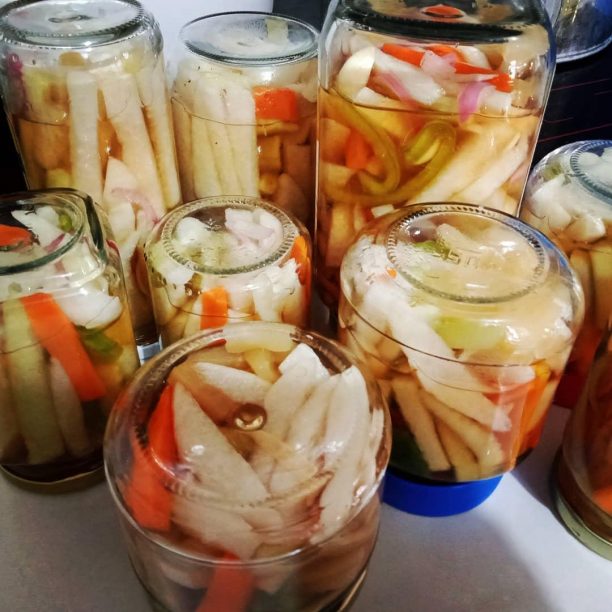 Pickled singkamas
Pickled singkamas
Meanwhile, Annette’s adventurous palate spurred her on to make variations of kimchi—from the usual cabbage to the more unusual combos of apple-radish and kalabasa-sayote (squash-chayote). “Apple-radish kimchi is my favorite! It’s crunchy and sweet. The kalabasa-sayote is creamy and has a nice bite to it.” She also loves fermenting chilis, spicing them with ginger and turmeric, and the more exotic cinnamon and cardamom. “The chilis are great as a sauce. I don’t need to buy hot sauce anymore. After blending and straining my chili sauces, I fry up the pulp and make another sauce—like the chili-garlic you put on siomai, but with a different flavor. The last one I made had apples and raisins in it.”
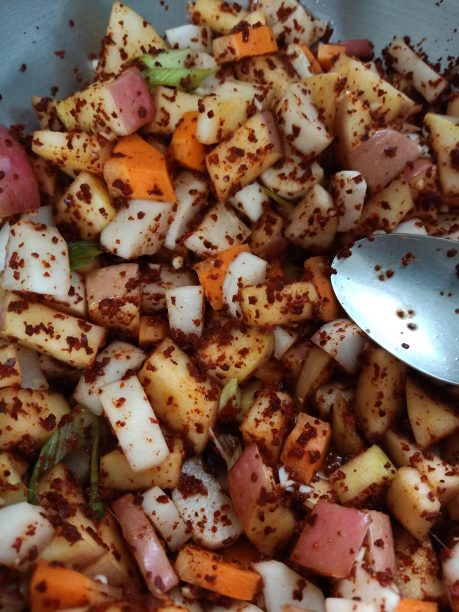 Apple-radish-carrot kimchi
Apple-radish-carrot kimchi
Pickling in the time of a pandemic
Life during a pandemic is rife with uncertainties. For Chie and Annette, pickling is part of the new normal of being self-reliant and thrifty. Chie explains, “We’ve been able to save money and cut down on waste. The vegetable peels, seeds and scraps, we either put in the compost bin or plant in containers.”
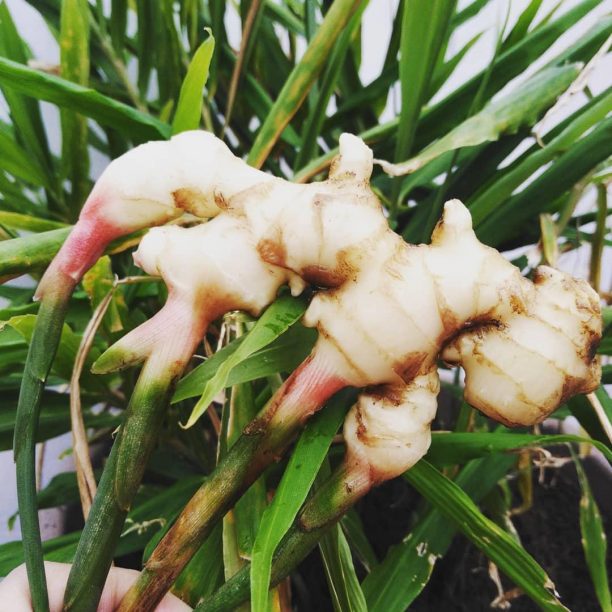 Chie’s ginger harvest
Chie’s ginger harvest
Though Annette is fully aware of how fermentation is an economical and practical means of preserving food, the process also fulfills her on various levels. “It is creative, intellectual, manual, but also nourishing, and a part of resistance and independence. If we only know how to buy our food, we are only consumers in the capitalist system—and there is only ‘one taste’ to things such as sinigang, kare-kare, pancit canton because we eat them from commercial spice mixes. But by making our own food, we are more in touch with our history and culture. Sandor Katz, a fermentation revivalist, says that fermenting is resistance to the idea that bacteria is bad, that everything should be sterile. Fermentation gets us in touch with worlds that are not just ours—the world of yeasts and bacteria.”
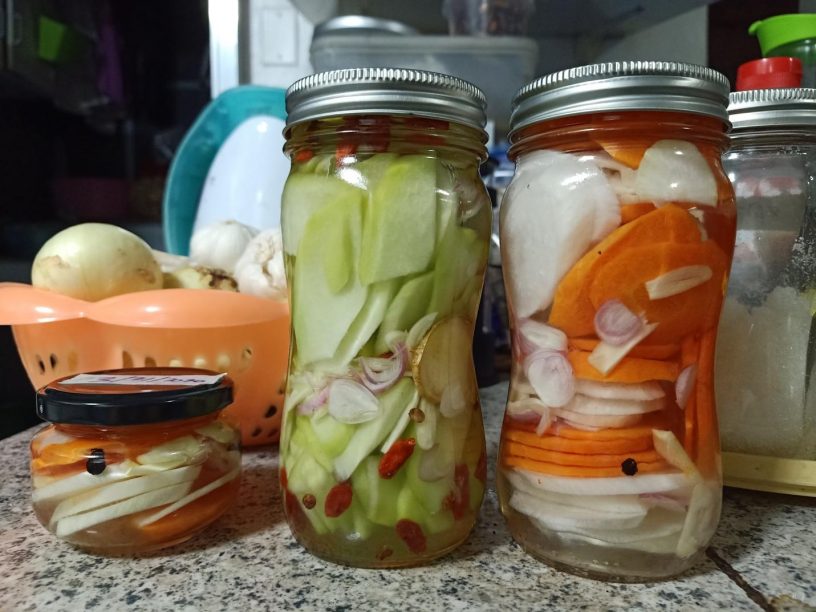 Annette pickles sayote ang goji berry (center); singkamas and carrot (right)
Annette pickles sayote ang goji berry (center); singkamas and carrot (right)
Never-ending gastronomical journey
Both women’s forays into food preparation don’t end with pickling. Chie’s roof deck has become a haven for her container gardens of herbs and vegetables. She also makes homemade yogurt, her family’s source of probiotics that promote digestive health.

Chie dries her basil
Annette has taken on making her own vinegar from fruits such as pineapple, banana, orange and jackfruit. Recently, she’d bought a dehydrator and has since been making dried fruits. “They’re like candy! During the ECQ, we would go to the market once every two weeks. Sometimes, we try to stretch it to three weeks. So you can imagine how the fruits needed to be consumed first. By week two or three, we don’t have any more.”
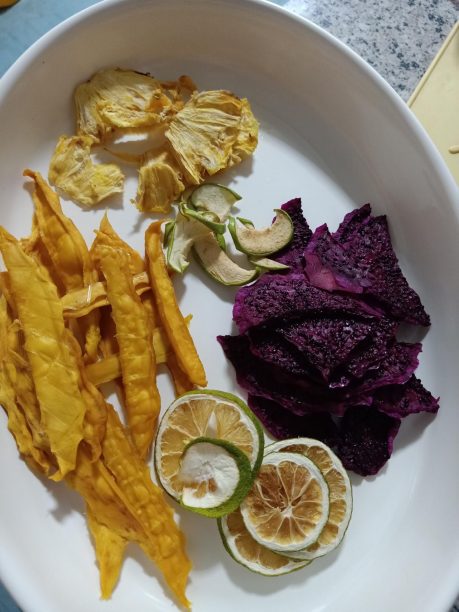 (clockwise) Annette’s dried mango; pineapple; apple; dragonfruit; dayap
(clockwise) Annette’s dried mango; pineapple; apple; dragonfruit; dayap
As for those who want to try pickling, Chie advises, “The most important tip is to make sure you pick the freshest vegetables. Different vinegars yield different tastes. I’ve used rice wine vinegar, apple cider and good old cane vinegar. I still have lot to learn. I am a rookie pickler and Google is my friend.”
Annette encourages beginners to follow their palate. “Start with something you like to eat— if it is kimchi or vinegar, or pickles, or hot sauce! That first success is so encouraging, so aim for simple projects first, then expand.”
4 cloves garlic, minced Half inch ginger, chopped 1 large Fuji apple or 2 small, chopped into 3/4 inch cubes 1 large daikon radish, chopped into 3/4 inch cubes 1 medium carrot, chopped into 3/4 inch cubes 1 bunch spring onions, sliced into 1.5-inch length 1 heaping tablespoon of rock or sea salt Fish sauce to taste 1-4 tablespoons gojugaru or Korean red pepper flakes
- In a large bowl, combine the apple, carrot, radish, salt, garlic, and ginger. Let it sit for about 15 minutes.
- Mix ingredients to check if they have released their juices. Add fish sauce and more salt if necessary.
- Add in 1-4 tablespoons of gojugaru or to taste, depending on how spicy you like it.
- Add in spring onions and stir everything to combine well.
- Transfer the fresh kimchi into a clean glass jar with a non-metallic lid. With a large spoon or with your fist, pack down the kimchi so that the vegetables are submerged in their own juices. Leave about an inch of space at the top of the container for fermentation.
- Cover with the lid and set aside at room temperature overnight or for 2-3 days, depending on how sour you want your kimchi to be.
- When the kimchi has arrived at the level our sourness you enjoy, transfer into the fridge to slow down the fermentation process.
By Amor Larrosa and Desserie Dionio, Panahon TV Reporters
Gunshots echoed as protesters hurled stones against the police. Blasts of water cannons were directed toward rallyists, who ran for their lives amidst deafening screams. According to reports, such was the scene that unfolded in Kidapawan in Cotabato that took the media by storm on the first day of April – an incident that would later be tagged by others as “Bigas, Hindi Bala.”
On March 29, 500 El Niño-stricken farmers and agricultural workers staged a rally in front of the National Food Authority (NFA) in Kidapawan City to ask the government for rice rations and aid after the El Niño had dried up their crops, leaving them penniless, in debt and hungry.
The local government agreed to talk to the farmers, but on March 30, their numbers rose to 6,000, allowing them to occupy the highway. A couple of days later, the event led to a violent dispersal, killing two farmers and one civilian, with more than a hundred protesters and members of the police wounded, and 80 farmers missing.
TWO SIDES OF THE COIN
Last April 7, the Senate Committee on Justice and Human Rights held a hearing in Davao City as some of farmers who were still recovering from injuries could not travel to Manila.
During the session, a farmer named Arlyn Oti Aman recalled how she, along with colleagues, were treated violently. “We went here to ask for food, but they looked upon us as like dogs, like animals.”
Meanwhile, the Philippine National Police (PNP) claimed that they have proof that the demonstrators initiated the violence. North Cotabato Chief Police Senior Supt. Alexander Tagum said that maximum tolerance was implemented during the outbreak of violence. He also showed an aerial video of the incident showing that cops were not raising their batons.
There are always two sides to every story, but what’s certain is that one of the factors that sparked the Kidapawan violence is the El Niño. This phenomenon aggravated the Dry Season in Mindanao, threatening food security.
WHAT IS EL NIÑO?
El Niño is characterized by the unusual warming of the ocean or the unusual rise in sea surface temperature (SST). According to the National Oceanic and Atmospheric Administration (NOAA), the term El Niño was originally recognized by fishermen off the coast of South America as the appearance of uncommon warm water in the Pacific Ocean.
“El Niño” is also a Spanish term meaning “Little Boy” or “Christ child” because this phenomenon usually arrives around Christmas.
WARNING
As early as 2014, PAGASA warned the public about the possible threat of El Niño, which was expected to bring below-normal rainfall patterns and higher air temperatures. Though the average number of tropical cyclones could still be normal, PAGASA stated that the El Niño could affect the cyclones’ movement and intensity, causing them to be stronger and more erratic.
EL NIÑO SETS IN
On March 11, 2015, PAGASA confirmed the ongoing El Niño in a press statement.
In the same month, the Dry Spell started to affect farmlands and water sources in Kidapawan City. The veterinary office in the city also reported deaths of hogs and cows because of the severe heat. The city office also received reports that some farm animals had weakened, possibly due to heat stroke.
After enduring the effects of El Niño for months, North Cotabato was placed under a state of calamity on January 2016. Thousands of hectares of farmlands and millions of crops like rice, corn, cacao, and other high-value crops were affected.
MINDANAO’S WEATHER
Provinces that are vulnerable to the effects of El Niño are mostly in Mindanao, mainly because of its location. According to PAGASA-Climate Monitoring and Prediction Section (CLIMPS) Chief Mr. Anthony Lucero, areas which are at the nearest distance from the equator normally experience the highest temperatures and least precipitation.
“Kapag kasi may El Niño, nagkakaroon ng reversal of winds—5 degrees north and 5 degrees south of equator. Humihina ‘yung effect ng Easterlies pagdating sa part na ‘yun. So walang moisture, wala ring ulan,” Lucero said.
This April, North Cotabato remains to be on the list of areas that are more likely to experience drought. Drought is defined by three consecutive months of way-below normal rainfall condition, wherein the average rainfall is reduced by 60%.
WERE WE PREPARED FOR EL NIÑO?
In the Senate Committee hearing, Cotabato Governor Emmylou Taliño Mendoza stressed that the provincial government took El Niño-mitigating measures after being warned by PAGASA.
Meanwhile, the Department of Agriculture (DA) Secretary Proceso Alcala belied reports that farmers in Mindanao have become hungry because of the government’s failure to prepare for El Niño. According to Alcala, when PAGASA declared a mild El Niño, the DA immediately provided P2.666 billion worth of mitigation assistance as early as 2015. He also said that P979.9 million worth of assistance was released from January to March 2016, including the provision of water pumps.
According to Alcala, DA’s projection of palay harvest loss due to El Niño for 2016 to date is 970,000 metric tons; “But the actual loss was 203,000 metric tons, meaning that the government has implemented the necessary interventions.”
From April to July this year, DA targets to distribute a total of 89,260 bags of rice varieties and seeds; 80,000 kilograms of soil ameliorant/zinc sulphate; and 5,000 bags of organic fertilizer for distribution to affected farmers.
As early as January, Pasig City Representative Roman Romulo called for the administration to disclose how it intended to spend the multimillion-peso budget for El Niño mitigation.
Likewise, in his statement during the hearing, Majority Floor Leader Alan Peter Cayetano condemned the administration for its failure to immediately release funds to mitigate the effects of El Niño.
“Enough of excuses and lies: we actually have P45 billion worth of funds in 2016 that may be used for the projects that will curb the impact of this crisis. If the Palace wanted to resolve this, they can… why are there so many farmers who are still starving and facing poverty?” said Cayetano.
EL NIÑO AND CLIMATE CHANGE
In an interview with the World Wide Fund for Nature (WWF), Atty. Gia Ibay said climate change does not cause El Niño, but the frequency of El Niño occurrence may be linked to it.
Lucero affirms this, saying it is a common misconception that El Niño is caused by climate change. He added that though El Niño is a natural occurrence, climate change may worsen its effects.
“Sa nakikita natin in the recent years, dumadami at dumadalas ang pagkakaroon ng disasters dahil sa climate change – kasama dun ‘yung drought. Ang climate change, connected sa pagtaas ng temperatura ng mundo. So kapag nagkaroon ng El Niño, lumalala ang effect. Mas mainit at lalong nagkukulang sa ulan,” Lucero explained.
According to Lucero, the current El Niño is still categorized as “strong” but is expected to weaken in the next few months. Probably by the end of July, our country may experience a “neutral” climatic condition.
AWARENESS + PREPAREDNESS
To date, the PNP has started its own inquiry on the Kidapawan dispersal, but there are calls for the National Bureau of Investigation (NBI) to conduct a parallel probe to ensure an impartial and independent investigation.
Meanwhile, in Senator Loren Legarda’s press release, she said that this incident would not have happened if necessary interventions addressed the impact of El Niño on farmers and communities.
“…the government can no longer deny the link between climate change and development. What we saw is just one of the human faces of climate change and our farmers, who did not cause this phenomenon, is among the direct victims of its impacts,” Legarda stated.
With the increasing frequency of El Niño and extreme weather events, it is evident that we are already facing a serious challenge. We have all been warned about the development of an El Niño phenomenon, but awareness is not enough without preparedness. It is the state’s responsibility to see to it that measures are effectively carried out from planning to implementation, making sure that the very backbone of the country’s food security—the farmers—benefit from them.
Related articles:
Panahon TV Blog: Decrypting the Dry Spell
Panahon TV Blog: El Niño getting stronger, threatens PH until 2016
REFERENCES:
http://davaotoday.com/main/human-rights/we-were-treated-like-animals-woman-tells-senate-hearing-on-kidapawan-carnage/
http://news.pia.gov.ph/article/view/1541460006387/senate-hearing-on-violent-kidapawan-protest-held-in-davao
http://www.da.gov.ph/index.php/media-resources/news-release/2016-news-release/7456-agri-chief-belies-media-reports-that-mindanao-farmers-going-hungry-due-to-el-nino
http://www.gov.ph/2016/04/05/govt-intensifies-efforts-combat-el-nino/
https://www.senate.gov.ph/press_release/2016/0407_escudero2.asp
National Oceanic and Atmospheric Administration (NOAA)
PAGASA-DOST
Greenpeace Philippines
www.mindanews.com
http://www.philstar.com/nation/2016/01/21/1544611/north-cotabato-under-state-calamity-due-el-nino
http://www.senate.gov.ph/press_release/2016/0405_legarda1.asp
According to the Philippine Atmospheric Geophysical and Astronomical Services Administration (PAGASA), a dry spell has been affecting different parts of the country since December 2014. Dry spell happens when below the normal rainfall conditions (21% to 60% reduction from average) are experienced within three consecutive months or two consecutive months of way below normal rainfall conditions (more than 60% reduction from the average). As of April 7, 2015, 30 provinces have been affected – 13 in Luzon, 3 in Visayas and 14 in Mindanao.
PAGASA Weather Forecaster Meno Mendoza clarified that the dry spell is a normal phenomenon in the Philippines. However, this year’s spell is triggered or worsened because of the ongoing weak El Niño.
Prior to the termination of the northeast monsoon, PAGASA issued the first El Niño advisory in early March. In a press statement dated March 11, 2015, an on-going weak El Niño was confirmed through the climate monitoring and analyses of the state weather bureau. El Niño is a climatic condition characterized by the unusual warming of the ocean or an increased sea surface temperature (SST) in the central and eastern equatorial Pacific (CEEP).
According to the National Oceanic and Atmospheric Administration (NOAA), the term El Niño was originally recognized by fisherman off the coast of South America as the appearance of uncommon warm water in the Pacific Ocean. “El Niño” is also a Spanish term meaning “Little Boy” or “Christ child” because this phenomenon arrives around Christmas.
In Philippine context, the weak El Niño is expected to bring below the normal rainfall pattern and warmer air temperatures in different parts of the country in the coming months. Though the average number of tropical cyclones could still be normal, PAGASA has stated that weak El Niño could affect the cyclones’ movement and intensity, causing them to be more erratic and stronger.
Dry spell on electricity and agriculture
Along with the rise in temperatures, the Manila Electric Company (Meralco) said that electricity consumers might also experience an increased generation charge in their bills.
According to Meralco, electricity rates on April went up by 27 centavos on the back of the one-month maintenance shutdown of the Malampaya gas field, which forced power plants to use the more expensive liquid fuel. The overall electricity rate in April is P10.68 per kilowatt-hour, higher than the P10.42 per kwh rate in March, but lower than April 2014’s P11.49 per kwh. Energy Secretary Carlos Jericho Petilla said in an interview with the Philippine Star that the more critical period is in May, with demand expected to shoot up to as high as 9,100 megawatts.
Despite the escalating temperature, power industry players believe that the Luzon grid may survive the hot and dry season because there are no expected blackouts as feared by the public.
But the dry spell has posed a more concrete threat to the farming industry.
Zamboanga City has already been placed under a state of calamity. Reports said that as of March 30, the dry spell and bush fires have resulted to extensive damage in hectares of rice, corn, vegetables, bananas, cassava and coconuts amounting to more than P132 million.
Meanwhile, the Provincial Disaster Risk Reduction and Management Council also declared M’lang and Kabacan in North Cotabato under a state of calamity. Due to dry spell, about P230 million worth of crops were reportedly damaged. Aside from the occurrence of grass fires, the absence of rains the past couple of months has also worsened the situation.
If humans feel the effect of soaring temperatures, animals suffer from their impact, too. The veterinary office in Kidapawan City reported that at least seven hogs and a cow died because of severe heat. The city office has also received reports that some farm animals have weakened, possibly due to heat stroke.
Water Conservation
Conserving water is a must during this current dry spell in the Philippines. Here are some of the water conservation tips that you can begin in your home:
Check and Fix. Regularly check your faucet for leaks. A small drip from an impaired faucet can waste gallons of water per day. Also, check your toilets for leaks. The rule is if there’s a leak, repair it immediately.
Turn it off. Make it a habit to turn off the faucet when not in use— even just for a short time while soaping hands, brushing your teeth and scrubbing the dishes.
The National Water Resources Board (NWRB) suggests turning off the faucet firmly to prevent leakage. It is better to install low volume/high pressure (LV/HP) nozzles or flow constrictors to reduce water usage by up to 50%.
Pair a pail with a dipper. When taking a bath, use a dipper and pail instead of always using the shower. In this way, you’ll be utilizing just the right amount of water.
Shorten baths. Due to the blazing heat, many of us love to take our time in bathing. However, this can contribute to the dry spell. By reducing your bath time by a couple of minutes, you can save gallons of water per day.
Get it fully loaded. It is recommended to wash only full loads in your washing machine to save water. You can also adjust the water levels to match the size of the load.
Know when to water your plants. Watering your plants is best done during the early morning or in the late afternoon. Early morning helps prevent the growth of fungus, and is also a defense against garden pests. Doing this can also reduce water loss or evaporation.
For energy saving tips, read here:
Going Beyond Earth Hour | Panahon TV Blog
Sources:
NOAA
NWRB
MERALCO
www.eartheasy.com
PAGASA-DOST
The Philippine Star
Manila Bulletin
Philippine Daily Inquirer
Philippine News Agency



